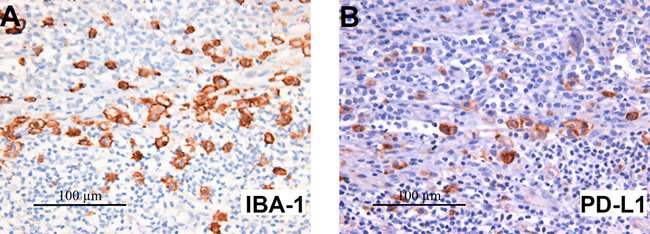PD-L1 expression in medulloblastoma: An evaluation by subgroup

This study evaluated the expression of PD-L1 and markers of immune mediated resistance in human medulloblastoma, the most common malignant pediatric brain tumor.
In cell lines, SHH MB, which are low-MYC expressing, demonstrated both constitutive and inducible expression of PD-L1 while those in Group 3/4 that expressed high levels of MYC had only inducible expression.
MB expresses low levels of PD-L1 facilitating immune escape.
"Tumors in the SHH subgroup are characterized by genetic alterations activating this key developmental pathway. WNT subgroup tumors have alterations in the wingless/ -catenin developmental pathway."
Most patients are assessed for PD-L1 expression prior to starting therapy, but the expression of PD-L1 during the entire course of treatment remains unclear, as does the relationship between changing PD-L1 expression and therapeutic responses.
In support of PD-L1 pathway activity in human MB, the researchers demonstrated that MB cell lines robustly up-regulated PD-L1 when they simulated an anti-tumor immune response in vitro by exposing the cell lines to recombinant human IFN-.
In further support of the notion that MB adaptively up-regulates PD-L1 as a specific response to immune mediated stimulation is the finding that radiation induced PD-L1 expression but not to the extent generated by IFN-.
The finding that both IFN- and radiation induced PD-L1 expression in vitro and the paucity of PD-L1 expression in vivo in the absence of TIL further emphasizes the concept that immune adjuvants will likely be needed to fully realize the benefit of PD-1 blockade in cold tumors such as MB.
Expression of MHC II by MB is unusual as this molecule is usually a feature of dendritic cells and other APCs indicating that this tumor may be directly inhibiting anti-tumor immune responses by masquerading as an inhibitory APC MHC II expression may also indicate a role for the immune checkpoint molecule, lymphocyte activating gene-3 in MB whose primary ligand is MHC II.
More information: Allison M. Martin et al. PD-L1 expression in medulloblastoma: an evaluation by subgroup, Oncotarget (2018). DOI: 10.18632/oncotarget.24951


















